
BRITAIN'S BATTERSEA SHELTER
Rescue center sets standard for animal care
Staff labors to find new homes for dogs, cats
5/15/2011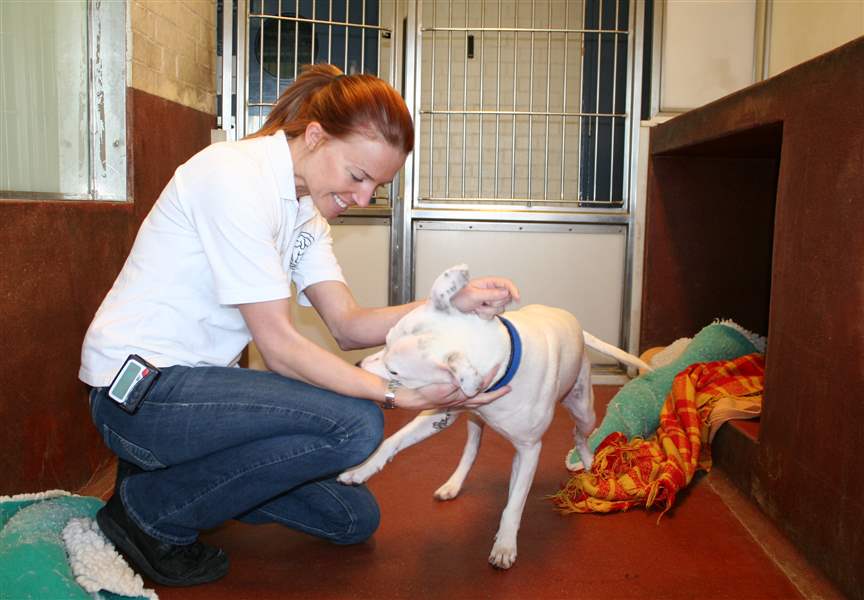
Claire Porteous, Battersea animal welfare manager, plays with Comet, a young Staffordshire bull terrier.
The Blade/Claudia Boyd-Barrett
Buy This Image

Claire Porteous, Battersea animal welfare manager, plays with Comet, a young Staffordshire bull terrier.
LONDON — At the Battersea Dogs and Cats Home, animal welfare is not just a buzzword, it’s a finely honed art.
Stroll through the five-acre grounds of this world-renowned dog and cat shelter in south London, and you’ll find spotlessly clean and spacious kennels, climate-controlled cat pens, well-exercised and stimulated animals, and countless trained experts and volunteers working to make a difference in the lives of abandoned and unwanted pets.
It’s a place where any dog or cat is welcome and where staff work exhaustively to find each of them a new home.
“No one gets turned away,” said spokesman Charlotte Walsh as she recently gave a tour of the facility. “We’ll accept any animal regardless of its temperament, medical background, or its breed. … That’s something we’re really proud of. It’s quite unique, especially here in the U.K.”
Welcome to the oldest and most famous animal rescue center in Britain.
Founded in 1860 amid the harsh realities of Victorian England, Battersea Dogs and Cats Home has had more than 150 years to perfect its animal care and adoption strategies. It also has been a steadfast witness — and to some extent an instigator — of evolving attitudes toward animals over the past century and a half.
It originally opened as “The Temporary Home for Lost and Starving Dogs” in a London stable yard.
Founder Mary Tealby, a penniless divorcee about whom little is known, was deeply concerned about the number of stray dogs and cats roaming the streets of London at the time. But the Victorian press was less than enthusiastic about Ms. Tealby’s endeavor, deeming it immoral to help “dumb” animals while human beings suffered extreme poverty. It took an article by the venerable Charles Dickens for people’s attitudes to begin to shift.

Each year, about 6,900 dogs and 2,700 cats pass through the Battersea Dogs and Cats Home, which has its main center in south London.
Reception
These days, about 6,900 dogs and 2,700 cats a year pass through the doors of the Battersea Dogs and Cats Home. The animals are housed at the rescue organization’s main site in London or at its two other locations, in Brands Hatch, Kent, and Old Windsor, Berkshire, several miles outside the city.
Arrival at the shelter comes via two principal means: Animals are either picked up off the street by local authorities or they are brought in by owners unable to take care of them. Just under two-thirds of the dogs and close to half of the cats are strays.
London’s local governments, or districts, have their own dog wardens. However, many lack the space to house all the animals they take in, so they bring them to Battersea, a privately funded organization, Ms. Walsh explained.
The Battersea Dogs and Cats headquarters has numerous buildings and kennels. However, an animal’s journey begins in the all-important lost-and-found reception area. It is here that the dogs and cats — about 17 a day on average — are surrendered and from here are taken to be assessed by trained veterinary and behavioral specialists.
Owners who bring in animals are asked to fill out a detailed questionnaire, including information on the animal’s age, medical history, temperament, likes and dislikes, diet, and the kind of household it’s used to living in. These details help staff provide appropriate care to each animal and find it a suitable new home.
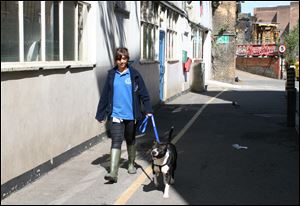
Alexia Demetriou walks Hank, a Staffordshire bull terrier. Animals are usually taken out at least once a day for a walk or to run around in specially built yards.
Assessment
All dogs and cats that enter Battersea go through a meticulous medical and behavioral screening process. The screening is performed in stages to allow each animal time to adjust to its new environment.
On first arrival, a veterinary expert will assess the dog or cat’s health, providing it with flea or worm treatments or neutering it as needed. A behaviorist also conducts a preliminary evaluation of the dog’s temperament. Dogs deemed to have severe behavioral or other difficulties are assigned specifically to trained experts and cannot be handled by volunteers.
The most important behavioral test comes a week after the dog or cat’s arrival. The waiting period is important because many animals react negatively to the kennel environment when they first arrive, and they need time to settle in and show their true personalities, Claire Porteous, animal welfare manager, explained.
“Some can be really withdrawn and will hide at the back of the kennel. They may be off their diet so not eating properly. They may have other medical issues,” she said. “You’re taking a dog that may have been in a family home at one point in its life and putting it in a kennel with lots of noisy dogs that are feeling a little bit on edge as well, and sometimes they sort of set each other off. So it’s a case of giving them a chance to get used to where they are.”
The behavioral test is performed by two trained experts, one who acts as an observer, the other interacting with the animal. If the animal is a dog, staff will take it for a walk so it can burn off energy before beginning the assessment.
During the test, the behaviorist plays with the dog to find out how it responds to different kinds of handling, how it reacts around adults, children, and other animals, and what its attitude is toward food and other stimuli. Ms. Walsh said the test involves lifting the animal’s paws and looking at its teeth and in its ears in ways that an owner might handle the dog, to see how it reacts. There is also a rough-play element to the assessment that investigates the dog’s response to firmer touches with hands.
With the information garnered by the assessment, the behaviorists prescribe appropriate care, training, and enrichment activities for each animal. They also put together a detailed description of the dog’s needs, temperament, and background that is used to help pair the animal with a suitable new owner.
Conditions
When an animal at Battersea’s London home is ready for adoption, it is moved to a kennel at the site’s specially designated “Kent Building.” It’s an enormous structure, with three floors and 44 kennels on each floor. The floors are connected via ramps because many dogs are uncomfortable using elevators and stairs, Ms. Walsh said.
The kennels are spacious and spotlessly clean. Each dog lives in an approximately 6-by-10-foot kennel. Every kennel also shares a 5-by-13-foot yard with the adjoining kennel, which staff open up frequently to allow dogs some extra space to move around in. The runs have windows that open to allow fresh air to circulate through the kennels.
As well as the expected sound of barking dogs, on entering the kennel facility you’re also likely to hear the sound of classical musicor sometimes talk radio.
It’s part of what Battersea staff call “kennel enrichment,” measures used to make the dogs’ stay at the facility more comfortable and stimulating. Enrichment activities include providing dogs with opportunities to interact socially with other dogs, staff, or volunteers, spraying calming scents throughout the kennels, and providing dogs with balls, bones, and other toys to play with.
Staff members also vary the way they feed the dogs, offering them food in bowls, other times scattering it about the kennel, and sometimes wrapping it in newspaper or putting it in a hollow cone-shaped toy that challenges the animal to use problem-solving and manipulative skills to get the food out.
“We try to turn their kennel environment into a dynamic environment, rather than something that’s just completely static,” Ms. Porteous said. “It reduces levels of stress for the dogs while they’re in such a stressful environment.”
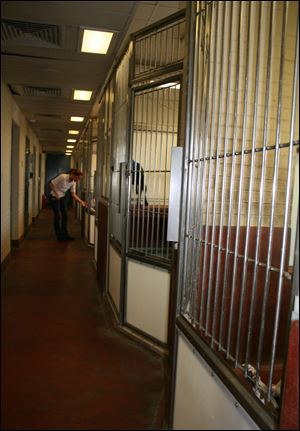
Claire Porteous tends to dogs up for adoption. The kennels are spacious and spotlessly clean. Each dog lives in an approximately 6-by-10-foot kennel.
The various enrichment measures help ensure the physical and mental well-being of the dogs, Ms. Porteous said. Without such efforts, animals could develop or face exacerbated health or behavioral problems, she indicated.
“If a dog doesn’t get out, then what you would likely see is it would deteriorate in kennels, show increasing signs of stress, being more vocal, red eyes, panting,” the animal expert said.
“You can’t say with 100 percent certainty that it’s preventable because all dogs have different personalities and different methods of coping with the stress. But it’s certainly something you can alleviate, and if you’re monitoring them very closely and giving them a decent amount of attention, then you can take steps to prevent that from happening.”
For some animals, the stress of the kennel environment is still too much. When that happens, staff may take a dog down to one of Battersea’s administrative areas to spend time around humans in a more relaxed atmosphere.
Puppies
Puppies are kept in a separate area of the Battersea Home. At the Kent Building, all of the dogs are adults, and the public is allowed to visit and meet the dogs. But the puppy facility is off-limits to all but staff and volunteers.
The restriction exists because puppies are at a vulnerable stage in their development, and their health could be jeopardized by frequent visits from outsiders, who may bring in germs or overexcite the animals, Ms. Walsh explained. Puppies are much easier to find homes for than are adult dogs, so staff match puppies with suitable homes before introducing them to their new owners.
“We have a lot of people coming in saying they want a puppy. We don’t need to have loads of people coming past getting the dogs upset,” Ms. Walsh said. “It’s quite carefully managed.”
Cats
In addition to its dog facilities, Battersea operates a cattery consisting of 90 climate-controlled “cat homes” or pens housing up to 150 cats or kittens. Each pen has a feeding station, toilet station, and sleeping station and is equipped with blankets, cushions, scratch pads, and toys. Volunteers come in frequently to pet and socialize with the cats, and the cats are sometimes allowed out of the pens to run around the facility.
On a recent morning, two new arrivals were curled up on cushions in one of the pens, timidly eyeing the shelter staff. They were brought to Battersea after their owner died. The animals were used to being together.
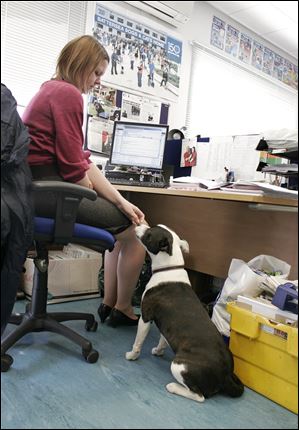
Dogs that become too stressed in kennels are taken to the administrative offices at the Battersea Dogs and Cats Home to spend a few hours in a more relaxed setting.
The cats would be prioritized for time with volunteers, Ms. Porteous said. Like the kennels, the cattery has its own enrichment program.
One of the cattery’s biggest claims to fame is its former resident “Larry,” a 4-year-old tabby adopted this year by British Prime Minister David Cameron. Larry is now dutifully employed as the prime minister’s rat catcher around his official residence at 10 Downing St. in London.
Finding a home
Ultimately, Battersea’s mission is to find each dog and cat that comes into its care a safe and secure new home.
The process is exhaustive in ensuring the new owner is as perfect a match as possible to the dog or cat selected. Members of the public interested in adopting an animal are asked to fill out a questionnaire about the kind of pet they are looking for and the type of household they live in. A Battersea staff member will then interview the potential owner and pay a visit to his or her home to ensure it meets the prospective animal’s needs.
Next, the person is invited to tour the Battersea Home and pick out animals he or she may be interested in adopting. Their selections are helped by cards next to each dog or cat’s pen that provide information about the animal’s character and the type of home it is suitable for. The public also can browse this information on Battersea’s Web site at battersea.org.uk.
“It’s a bit like online dating,” Ms. Walsh quipped.
A specially designated “rehomer” will discuss the selections with the potential owner. An adoption is approved only if Battersea’s staff deems the selection suitable. The owner will be given a full description of the animal’s background, behaviors, personality, and needs.
“We work really hard to make sure they are good matches,” Ms. Walsh said. “If we don’t get a good match, the animal will end up coming back.”
The home charges new owners the equivalent of $172 for each dog adoption and $107 per cat adoption. Each adopted animal is neutered, has received all of its initial vaccinations, flea, and worming treatments, and is fitted with a microchip. The fee also includes a collar, identification tag, and leash, three months’ outpatient care for illness contracted in the Battersea Home, a starter pack of food, and access to the shelter’s behavior advice line.
The advice line operates from noon to 5 p.m. Monday through Friday and offers help with issues such as house training, basic control, and separation problems.
“We think if we can give people advice, we can help them overcome problems and keep that dog in the home,” Ms. Walsh summarized.
Euthanasia
There is no time limit on how long an animal can stay in the Home. Some dogs and cats stay at Battersea for years before a suitable placement is found, although on average the stay is 30 days.
However, there are specific times when the organization determines that animals have to be put down. This happens to about one-third of the dogs and about 7 percent of cats that enter Battersea.
A key reason for euthanasia is that the dog is a type banned in the U.K.
The British government prohibits ownership of four types of dogs — “pit bull” terriers, Japanese Tosas, Dogo Argentinos, and Fila Braziliero — all of which are considered dangerous. Law requires that any such animal that comes to the Battersea Dogs and Cats Home be destroyed.
Secondly, animals with severe medical problems are put down if staff determine it would be unfair to keep them alive.
Finally, Battersea destroys dogs that its experts deem to be incurably aggressive.
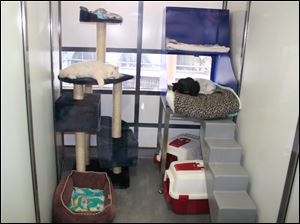
Battersea operates a cattery consisting of 90 climate-controlled ‘cat homes’ housing up to 150 cats or kittens.
In some cases, dogs can be found placements other than a family home environment, such as working as sniffer canines for the army or police.
“We would never just rule a dog out straight away because he might be aggressive,” Ms. Walsh said. “We’ll always take the time to explore every avenue: enrichment, giving it time in an office. But the bottom line is always the safety of staff and public.”
Funding
It costs money to run a home like Battersea.
The organization’s $21.5 million-a-year operating costs come almost entirely from private donations, bequests, and fund-raising. The only government funding is a small per-animal fee from local districts when the home takes in dogs on behalf of a warden, Ms. Walsh said.
A dedicated fund-raising team works to ensure the organization has the resources it needs. As well as asking for traditional donations, Battersea supporters are invited to sponsor a kennel or “Kitty Kabin” for about $8 a month and in return receive twice-yearly updates on the dogs and cats that have spent time in them.
Money is also raised through the sale of merchandise and pet accessories online and in shops at Battersea’s three centers. Other fund-raisers include raffle-ticket sales and fund-raising trips and treks.
Volunteers are another key to the shelter’s success, with 400 people donating their time regularly to help dogs and cats at the centers. Those volunteers come from all walks of life and include people such as Julie Gierus, who on a recent morning was walking “Sam” around Battersea’s London campus. Ms. Gierus earns money walking dogs elsewhere but has been doing it at no charge at Battersea for the past 12 years, coming twice a week. She said she keeps it up because she can see the difference she’s making in helping dogs who are going through a stressful time in their lives.
“I just love dogs,” she said. “I tell people it’s one of the most rewarding things you could possibly do.”
Volunteers as well as staff also contribute to Battersea’s mission to educate the public and prevent more animals from being abandoned, giving talks on responsible pet ownership at schools and for other organized groups.
“We think if we can prevent problems that’s much better than tidying it up afterwards,” Ms. Walsh stated.
Contact Claudia Boyd-Barrett at: cbarrett@theblade.com or 419-724-6272.
READ MORE